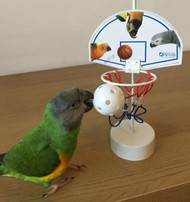Trick Training Overview by Sara Houston
Posted by Trick training Parrots, training your Parrot, learn the basics of trick training on 23/1/2024
Learn the basics of trick training by Sara Houston, who has taught her Senegal Scout lots of tricks.
We’re going to be breaking down tricks but before we do that let’s look at some bits to help us prepare.

Trick training overview:
Training tips:
– Don’t rush to progress to the next step. If you find the next step isn’t working, go back to the last step and work on it again.
– The first trick is the hardest trick – your Parrot has to learn to learn. Don’t worry if they don’t get it straight away. If you keep trying, they will get it eventually.
– Set up the environment and train in a place they’re happy with. Look out for distractions, other animals, people etc.
– Try training at different times of the day – sometimes they’ll have a preference.
– If your Parrot seems distracted, try again later or change the treats.
Frequently asked questions:
My Parrot isn’t food motivated or they’re not interested in the treat.
One of the biggest reasons Sara finds for a Parrot not responding to treats is because they can already get those treats freely. They’re popped in their cage daily or they get them when they’re out of the cage. This means they’re far less likely to want to do a trick to get that treat. Sara really recommends having treats that you only use for training.
How do I pick the perfect treat for training?
Think about what you Parrot enjoys as a treat normally. Do they like a few seed treats, NutriBerries or maybe some sugar snap peas.

Seed is fattening, should I still use it for training?
Sara uses seed a lot when training but it only makes up about 5% of Scout’s daily diet. A Parrot won’t train long enough for their training treat to make up their main diet.
Do I need any specialist equipment to train?
No, a lot of training can be done using objects around the home. There are also a lovely range of trick training toys to support your training and expand on trick training.
How long should I train for?
Sara likes to keep my training sessions short. Sometimes only doing a minute training session a couple of times a day when busy. 5-10 minutes per session is plenty for learning any trick. Sara always recommends training every day.
5 minutes every day is far better than 5 hours once a week. Think about when you have 1 or 2 minutes to train. Sara has known people train whilst they’re waiting for the kettle to boil or the washing machine to finish the last few minutes.
My Parrot can’t be handled, how do I train them?
If you can hand a treat to your Parrot through a cage bar, you can train them. Take a look at target training as you can teach this through the bars of the cage. Then move to getting them to target onto your hand. They’ll grow much more comfortable with you and associate you with treats. This can really help with bonding with them too.
Training terms:
Positive reinforcement
Positive simply means to add, reinforcement means something that increases the likelihood of the behaviour and positive reinforcement means something is added to encourage the behaviour. Sometimes known as force free training or R+. All the tricks we learn here use positive reinforcement.
Example: A treat is given when a Parrot does the correct behaviour to increase the likelihood of them doing it again.
Clicker
A small plastic object that omits a sound when clicked. A clicker is used to tell a Parrot they did the correct behaviour and a treat is coming. This is a bridge.
Bridge
Something used to bridge – say “yes you’ve done a good behaviour”
Treats
Food based rewards – these are an example of a primary reinforcer.
Primary Reinforcer
This is what your Parrot is working for. Examples are treats or a nice head scratch. Something your Parrot likes that is going to encourage them to do a trick in order to receive the primary reinforcer. The most common one is a treat.
Mark
To mark a trick is to tell your Parrot the exact moment they are doing it right. For example, you may use a clicker or say good every time a Parrot lifts their foot when you’re teaching them to wave. You are marking the wave.
Target
Something you want a Parrot to touch or stand on.
Lure
To use a food object to get a Parrot to guide them to a position or behaviour.
Look out for future blogs explaining how to teach your Parrot tricks soon.
Trick Training Overview
Target Training
Trick Training Academy
Clicker Training

